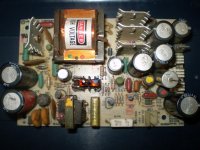Al Hartman
Veteran Member
Last year, I bought a Model III from M.A.R.C.H. at the estate sale last summer (a local collector had died, and M.A.R.C.H. was helping the widow sell off his collection.)
It was a two disk drive 48k unit. One disk drive had a broken latch. The unit powered up to garbage, and there was no floppy access. The floppy controller to logic board cable was bad.
I got it home, removed all the RAM, cleaned the corrosion of the legs and reinserted them and the unit worked OK as a cassette unit. My friend came over and we soldered in headers and used a 40 pin cable to replace the floppy controller cable, but the floppies still didn't work because the power supply was bad.
I bought a replacement supply in January, but didn't get to put it in until yesterday.
It now boots to floppy though the drive 0: is bad. Hopefully, the bad drive can be fixed. We took the good door from the 0: drive which didn’t read disks, and moved it to the 1: drive which worked but had a bad door latch.
My friend Tom is going to fix the broken latch and see if the drive will work after a cleaning and speed adjustment. I was out of alcohol, and didn’t have a florescent lamp for the speed test.
The model III also has a bad keyboard, so if anyone runs across a Model III keyboard that works, let me know.
So, incremental progress was made. And I know what I need to get it running fully.
If anyone wants to buy the bad supply and fix it, drop me a line with an offer. I'm trying to pull together cash to buy a new keyboard.
It was a two disk drive 48k unit. One disk drive had a broken latch. The unit powered up to garbage, and there was no floppy access. The floppy controller to logic board cable was bad.
I got it home, removed all the RAM, cleaned the corrosion of the legs and reinserted them and the unit worked OK as a cassette unit. My friend came over and we soldered in headers and used a 40 pin cable to replace the floppy controller cable, but the floppies still didn't work because the power supply was bad.
I bought a replacement supply in January, but didn't get to put it in until yesterday.
It now boots to floppy though the drive 0: is bad. Hopefully, the bad drive can be fixed. We took the good door from the 0: drive which didn’t read disks, and moved it to the 1: drive which worked but had a bad door latch.
My friend Tom is going to fix the broken latch and see if the drive will work after a cleaning and speed adjustment. I was out of alcohol, and didn’t have a florescent lamp for the speed test.
The model III also has a bad keyboard, so if anyone runs across a Model III keyboard that works, let me know.
So, incremental progress was made. And I know what I need to get it running fully.
If anyone wants to buy the bad supply and fix it, drop me a line with an offer. I'm trying to pull together cash to buy a new keyboard.

